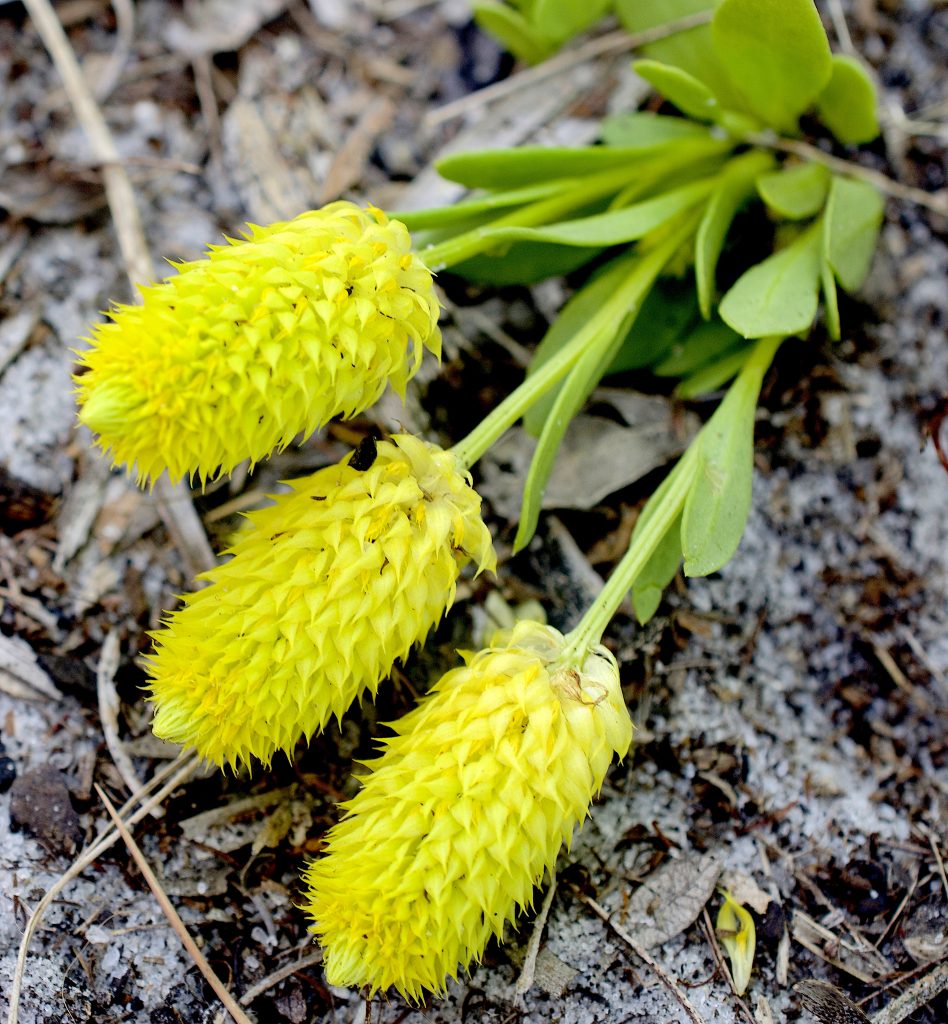
Candyroot can be yellow or orange, tall and short.
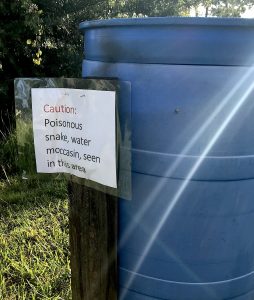
Rising water creates snake warning.
Is it the season or is it the rain? In May or so one starts to see Candyroot, a common woodland plant. This past week they were flowering in excess in Wickham Park, Melbourne Fl. They could have been responding to recent rains, or, the ditch they like to grow in has been too wet to mow thus they have been allowed to grow to flowering maturity. While the Native Plant Society frets over invasive species we tend not to think about all the natives mowing destroys. The United States has 36 million acres of lawn and 31 million acres dedicated to recreational horses (are there any “working” horses now days?) Those 77 million acres could easily feed America if used for ruminant agriculture. As for Candyroot… it barely makes it into the edible realm and actually is more medicinal (outside my pay grade.) I wonder what its methyl silicate would do for a snake bite? As the ditch was wet thus unmown another native apparently took advantage of the situation, water moccasins. You can read about Candyroot here.
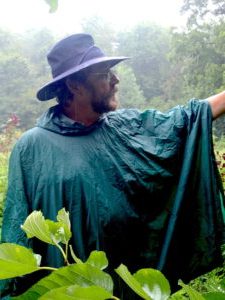
Classes are held rain or shine (but not during hurricanes.)
Foraging Classes: Not quite south Florida the LeStrange Preserve in Ft. Pierce features a man-made lake and a lazy natural river (whose old bed we can wander along.) This Sunday we’re at Mead Garden in Winter Park, a location that perhaps has the greatest diversity of edible plants in it. What we do at most locations is wander around for three hours looking at all the edible plants in the area.
Saturday July 31 George LeStrange Preserve, 4911 Ralls Road, Fort Pierce, FL, 34981, 9 a.m. to noon.
Sunday August 1st, Mead Garden: 1500 S. Denning Dr., Winter Park, FL 32789. Meet at the bathrooms. 9 a.m. to noon. Entrance to the park is on Denning. Some GPS get it wrong
Saturday August 7th, Spruce Creek Park, 6250 Ridgewood Ave. Port Orange, 32127. Meet at the pavilion, 9 a.m. to noon.
Sunday August 8th, Dreher Park, 1200 Southern Blvd., West Palm Beach, 33405. 9 a.m. to noon, meet just north of the science center.
Saturday August 14th, Bayshore Live Oak Park, Bayshore Drive. Port Charlotte. 9 a.m. to noon. Meet at the parking lot in the park on Bayshore at Ganyard Street.
You can bring cash on the day of class or click here to pay for your class
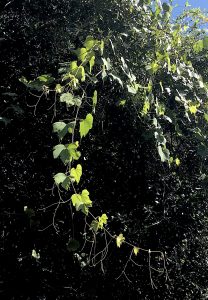
A good example of forked-tendril grapes in this case in Gainesville. To read more about grapes go here.
A good date to keep in mind for wild grapes is September first. That said you can find some as early as late July, or as late as November and occasionally at other times as well. This past weekend we saw a few early grapes from two of the large groups here in Florida, single tendril and forked tendril. The latter is sweeter and far more reliable regarding its fruiting and use of leaves. The single tendril have clusters of six to eight grapes and tend to be high in acid and fruit irregularly. The forked tendril ones have sweet grapes and tend to fruit every year. Their leaves are also not as bitter as the single-tendril ones. You can read about grapes here, seem my video here.
My nine-DVD set of 135 videos has been phased out and replaced by a 150-video USB. The USB videos are the same videos I have on You Tube. Some people like to have their own copy. The USB videos have to be copied to your computer to play. If you want to order the USB go to the DVD/USB order button on the top right of this page. That will take you to an order form. I’d like to thank all of you who ordered the DVD set over the years which required me to burn over 5,000 DVDs individually.

Green Deane Forum
Want to identify a plant? Perhaps you’re looking for a foraging reference? You might have a UFO, an Unidentified Flowering Object, you want identified. On the Green Deane Forum we — including Green Deane and others from around the world — chat about foraging all year. And it’s not just about warm-weather plants or just North American flora. Many nations share common weeds so there’s a lot to talk. There’s also more than weeds. The reference section has information for foraging around the world. There are also articles on food preservation, and forgotten skills from making bows to fermenting food. 
Your donations to upgrade the EatTheWeeds website and fund a book were appreciated. A book manuscript has been turned it. It had 425 articles, 1326 plants and a third of a million words. What it will be when the publisher is done with it next year is unknown. It will be published in the spring of 2023. Writing it took a significant chunk of time out of my life from which I have still not recovered. (Many things got put off.) The next phase is to update all the content on the website between now and publication date. Also note as it states above the 135-video DVD set has been phased out for 150-video USB. Times and formats change. Which reminds me I need to revisit many plants and make some new videos.
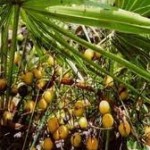
Saw palmetto berries half way to ripe.
Also a heads up regarding saw plametto berries. During classes this weekend I noticed many green saw palmetto berries are turning golden. They are still not edible. Usually in August they turn gold from green and by or in September they turn black. That’s when they are edible, in theory. They taste like vomit but are very nutritious having all the necessary amino acids. To the modern palate they are kind of like an intense blue cheese with some hot pepper tossed in. You can read about them here, see my video here.
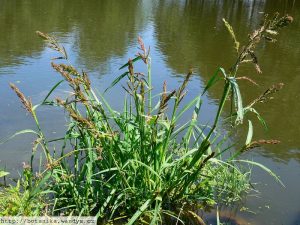
Barnyard Grass is the most misnamed grass in the world.
One would think that with a name like “Barnyard Grass” one would find it in barnyards. But no. It is probably safe to say you will rarely find Barnyard Grass in a barnyard. Why? Because Barnyard Grass likes to grow in water, lots of water. You can easily find it in ponds, streams and drainage ditches but not barnyards unless it is growing directly under the roof drain spout in a very low, wet spot. In all my years of foraging I have seen Barnyard Grass once in a barnyard but dozens of times in water. In wet areas look for a tall grass that resembles wheat. The stems will be hairy and usually purple at the base. One easy place to find them locally is in dried up lakes. Often at the still-damp low spot Barnyard Grass will colonize the entire low spot. Not a native it comes in season at the same time and one can find it seeding now. The grain is a bit more coarse than wheat but can be harvested, prepared and used the same way. You can read about Barnyard Grass here.
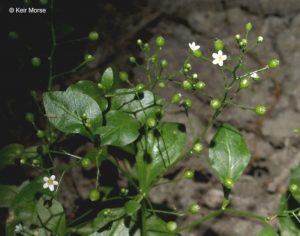
Brookweed grows bitter quickly. Photo by Keir Morse.
Brookweed, Samolus valerandi, is a bit strange. In my travels I have seen it in Jacksonville, at the tidal location, and in Sarasota in Red Bug Slough. It likes to be near fresh water and is a small plant. Fortunately its flower/seed arrangement makes it easy to identify when you’re looking for it. Not much is written about the species, few published books cover it. Mild young leaves are edible raw and are high in vitamin C. That was important when scurvy was a common problem (which is making a comeback in some cities.) Persimmon leaves also have high amounts of vitamin C. Brookweed has a bit more history of use in Europe. Usually young and tender leaves are what’s eaten. You can read about Brookweed here.
This is weekly newsletter #467. If you want to subscribe to this free newsletter you can find the sign-up form in the menu at the top of the page.
To donate to the Green Deane Newsletter click here.

